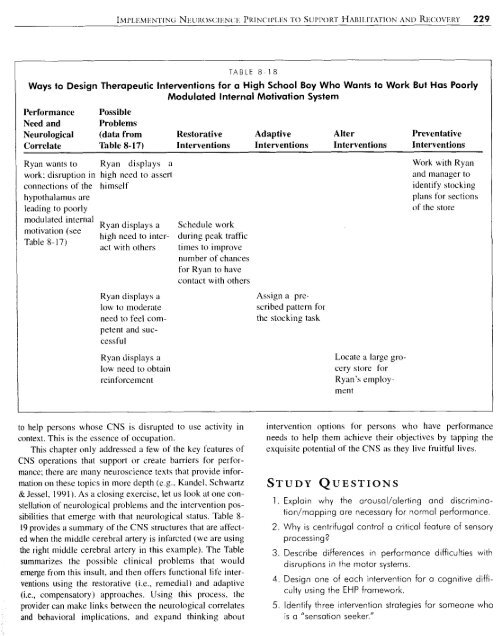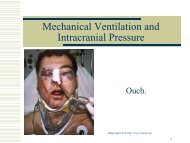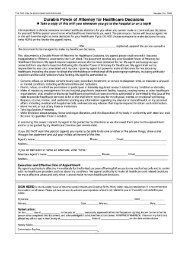Implementing Neuroscience Principles to Support Habilitation and ...
Implementing Neuroscience Principles to Support Habilitation and ...
Implementing Neuroscience Principles to Support Habilitation and ...
You also want an ePaper? Increase the reach of your titles
YUMPU automatically turns print PDFs into web optimized ePapers that Google loves.
TABLE 8-18<br />
Ways <strong>to</strong> Design Therapeutic Interventions for a High School Boy Who Wants <strong>to</strong> Work But Has Poorly<br />
Modulated Internal Motivation System<br />
Performance Possible<br />
Need <strong>and</strong> Problems<br />
Neurological (data from Res<strong>to</strong>rative Adaptive Alter Preventative<br />
Correlate Table 8-17) Interventions Interventions Interventions Interventions<br />
Ryan wants <strong>to</strong> Ryan displays a Work with Ryan<br />
work: disruption in high need <strong>to</strong> assert<br />
<strong>and</strong> manager <strong>to</strong><br />
connections of the himself<br />
identify s<strong>to</strong>cking<br />
hypothalamus are<br />
plans for sections<br />
leading <strong>to</strong> poorly<br />
of the s<strong>to</strong>re<br />
modulated internal Ryan displays a Schedule work<br />
motivation (see<br />
high need <strong>to</strong> inter- during peak traffic<br />
Table 8- 17)<br />
act with others times <strong>to</strong> improve<br />
number of chances<br />
for Ryan <strong>to</strong> have<br />
contact with others<br />
Ryan displays a<br />
low <strong>to</strong> moderate<br />
need <strong>to</strong> feel competent<br />
<strong>and</strong> successful<br />
Ryan displays a<br />
low need <strong>to</strong> obtain<br />
reinforcement<br />
Assign a prescribed<br />
pattern for<br />
the s<strong>to</strong>cking task<br />
Locate a large grocery<br />
s<strong>to</strong>re for<br />
Ryan's employment<br />
<strong>to</strong> help persons whose CNS is disrupted <strong>to</strong> use activity in<br />
context. This is the essence of occupation.<br />
This chapter only addressed a few of the key features of<br />
CNS operations that support or create barriers for performance;<br />
there are many neuroscience texts that provide information<br />
on these <strong>to</strong>pics in more depth (e.g., K<strong>and</strong>el. Schwartz<br />
& Jessel, 1991). As a closing exercise, let us look at one constellation<br />
of neurological problems <strong>and</strong> the intervention possibilities<br />
that emerge with that neurological status. Table 8-<br />
19 provides a summary of the CNS structures that are affected<br />
when the middle cerebral artery is infarcted (we are using<br />
the right middle cerebral artery in this example). The Table<br />
summarizes the possible clinical problems that would<br />
emerge from this insult, <strong>and</strong> then offers functional life interventions<br />
using the res<strong>to</strong>rative (i.e., remedial) <strong>and</strong> adaptive<br />
(i.e., compensa<strong>to</strong>ry) approaches. Using this process, the<br />
provider can make links between the neurological correlates<br />
<strong>and</strong> behavioral implications, <strong>and</strong> exp<strong>and</strong> thinking about<br />
intervention options for persons who have performance<br />
needs <strong>to</strong> help them achieve their objectives by tapping the<br />
exquisite potential of the CNS as they live fruitful lives.<br />
STUDY QUESTIONS<br />
1. Explain why the arousal/alerting <strong>and</strong> discrimination/mapping<br />
are necessary for normal performance.<br />
2. Why is centrifugal control a critical feature of sensory<br />
processing<br />
3. Describe differences in performance difficulties with<br />
disruptions in the mo<strong>to</strong>r systems.<br />
4. Design one of each intervention for a cognitive difficulty<br />
using the EHP framework.<br />
5. Identify three intervention strategies for someone who<br />
is a "sensation seeker."





